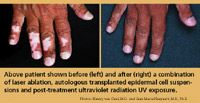- Case-Based Roundtable
- General Dermatology
- Eczema
- Chronic Hand Eczema
- Alopecia
- Aesthetics
- Vitiligo
- COVID-19
- Actinic Keratosis
- Precision Medicine and Biologics
- Rare Disease
- Wound Care
- Rosacea
- Psoriasis
- Psoriatic Arthritis
- Atopic Dermatitis
- Melasma
- NP and PA
- Skin Cancer
- Hidradenitis Suppurativa
- Drug Watch
- Pigmentary Disorders
- Acne
- Pediatric Dermatology
- Practice Management
- Prurigo Nodularis
- Buy-and-Bill
Article
Combination treatment proves effective
Ghent, Belgium — Repigmentation in patients with vitiligo is very hard to achieve, but a new study suggests that a combination of laser ablation, autologous transplanted epidermal cell suspensions and post-treatment ultraviolet radiation UV exposure produces repigmentation in a selected group of patients.

The conventional treatment for vitiligo is laser and subsequent UV exposure. Promising results with the transplantation of autologous epidermal cell suspensions are reported in the October 2004 Archives of Dermatology.
The studyStudy investigators Nanny van Geel, M.D., and Jean Marie Naeyaert, M.D, Ph.D., tested the effectiveness of the technique in a prospective randomized double-blind placebo-controlled study. The investigators compared standard treatment, laser alone versus laser treatment and transplantation of autologous non-cultured cell suspensions to determine whether one of the treatment strategies resulted in superior repigmentation outcomes. Both groups underwent post-treatment UV.
Promising results"What is particularly striking is that we found that among patients with stable disease, repigmentation occurred in at least 70 percent of the treated area, with 55 percent, 57 percent and 77 percent of the actively treated group demonstrating repigmentation at three, six and 12 months respectively, the researchers tell Dermatology Times. "So far, no patient with a segmental vitiligo lost the repigmented area, during a follow-up period of four years."
First signsAnother encouraging finding is that the first signs of repigmentation occurred at three weeks. These results are far better than those achieved with standard UV therapy or steroids, where repigmentation often occurs between one to four months.
One limitation of the investigational treatment is that it did not prove effective in patients with active disease, i.e. those with new or enlarging lesions. In patients with active disease, investigators found the inverse: 70 percent of lesions demonstrated no repigmentation response at any point.
Repigmentation patternThe research team also hoped to gain more insight into the pattern of repigmentation. They performed treatment at the border of a vitiligo lesion or in its center, with the goal of determining the repigmentation pattern. Specifically, they analyzed whether the repigmentation patterns were perifollicular, diffuse or migrating from the borders. In all but one patient, the pattern was diffuse.
"What this study has taught us is that we could demonstrate that repigmentation was primarily caused by the transplanted melanocytes. This finding is of great value for well-selected vitiligo patients having stable disease."





